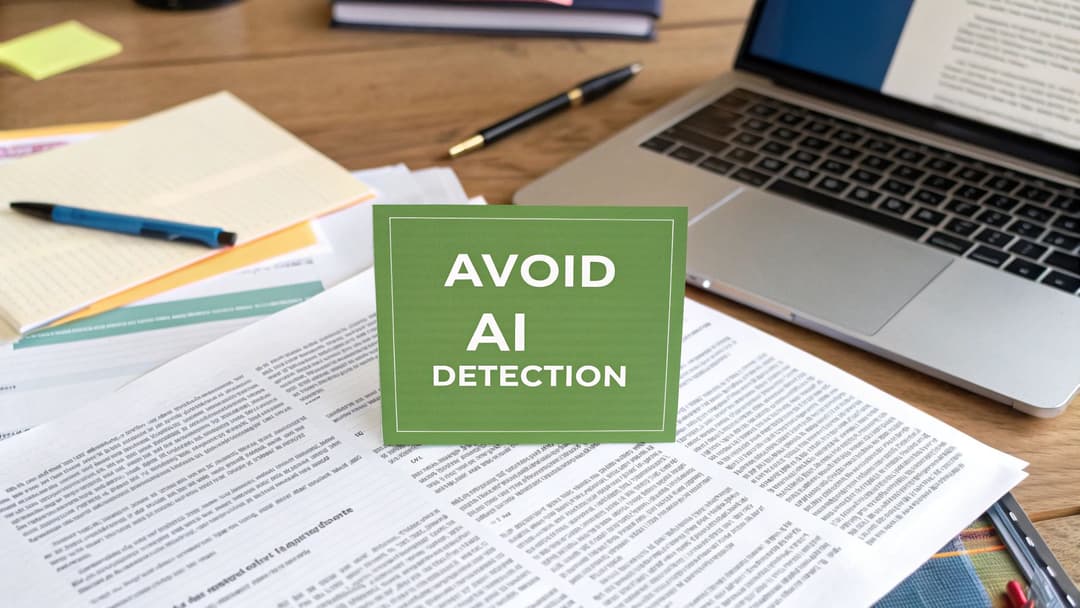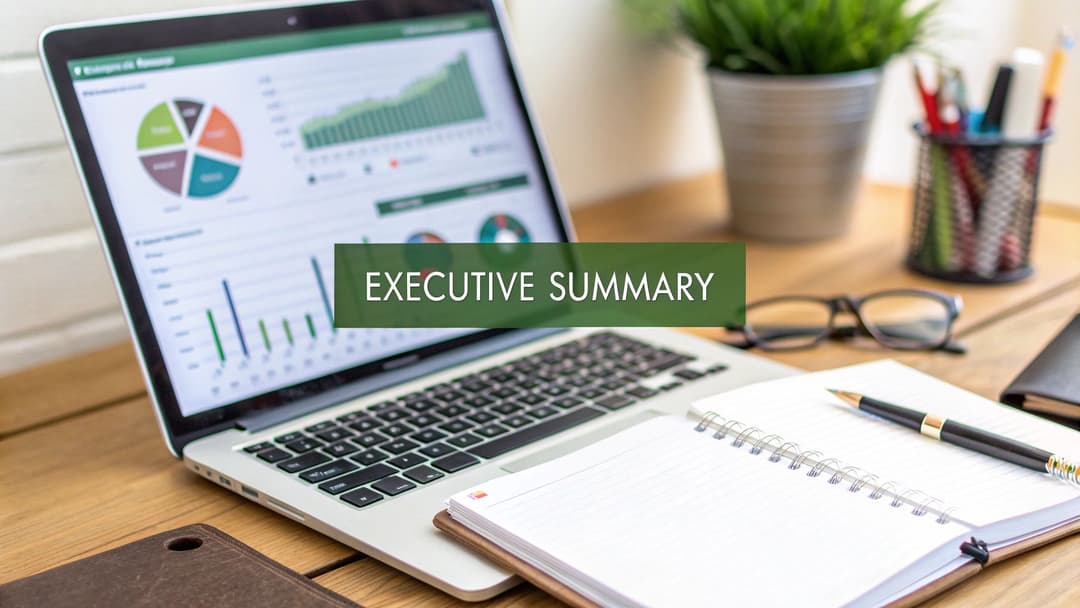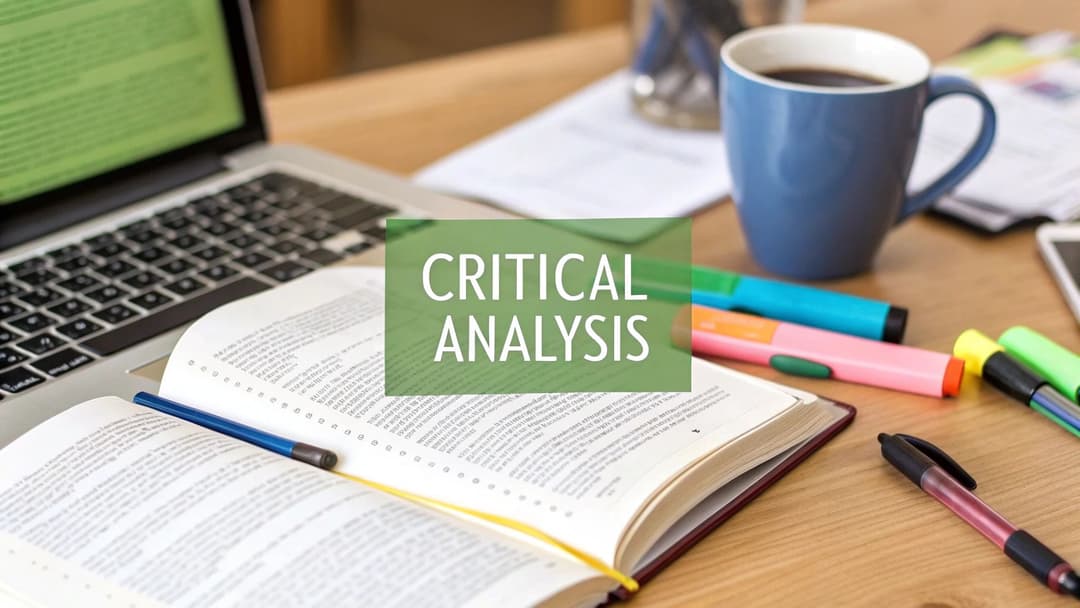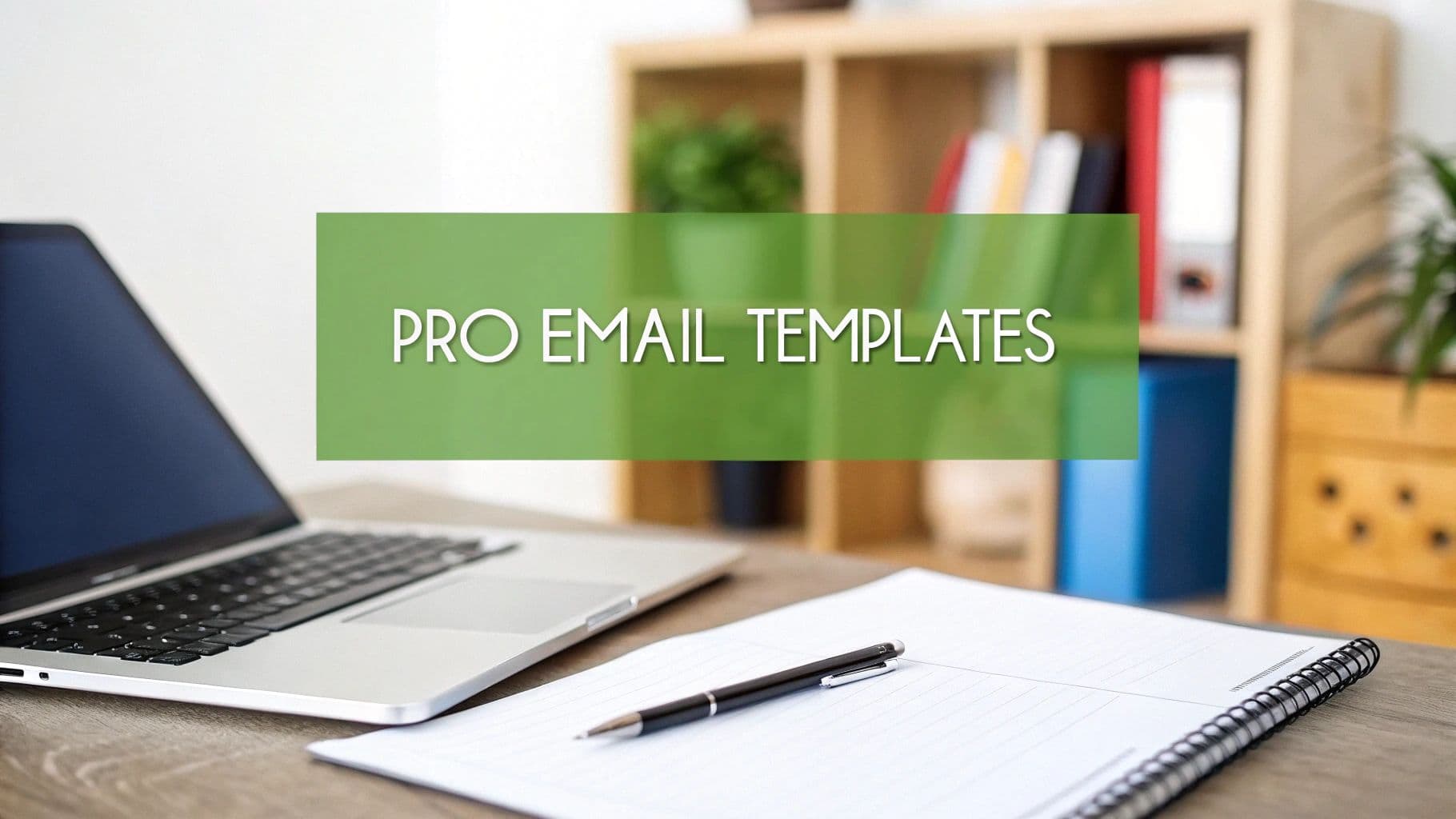
6 Professional Email Example Templates for 2025
July 5, 2025
In the modern workplace, your inbox is far more than a simple messaging tool; it's a powerful engine for professional advancement. A single, well-crafted email can open doors to new clients, secure pivotal meetings, and forge lasting industry relationships. Conversely, a poorly written message can close them just as quickly, often without you ever knowing why. This is where mastering the art of the professional email becomes a non-negotiable skill.
This guide moves beyond generic advice and vague templates. We will dissect six essential types of professional communication, providing a complete professional email example for each critical scenario. You will see exactly how to structure a message, what language to use, and the strategic thinking behind every choice.
Forget the guesswork. We will break down each example, revealing the specific tactics that drive results. From a cold outreach that demands a response to a follow-up that seals a deal, you'll gain a replicable blueprint. Prepare to transform your inbox from a source of stress into your primary tool for building connections and achieving your career goals.
1. The Cold Outreach Email
The cold outreach email is a powerful tool for initiating contact with individuals you've never met. Unlike spam, this professional email example is highly personalized and aims to provide immediate value, opening the door for potential business relationships, partnerships, or client engagements. The core principle, popularized by authors like Aaron Ross in "Predictable Revenue," is to make a compelling introduction that respects the recipient's time and intelligence.
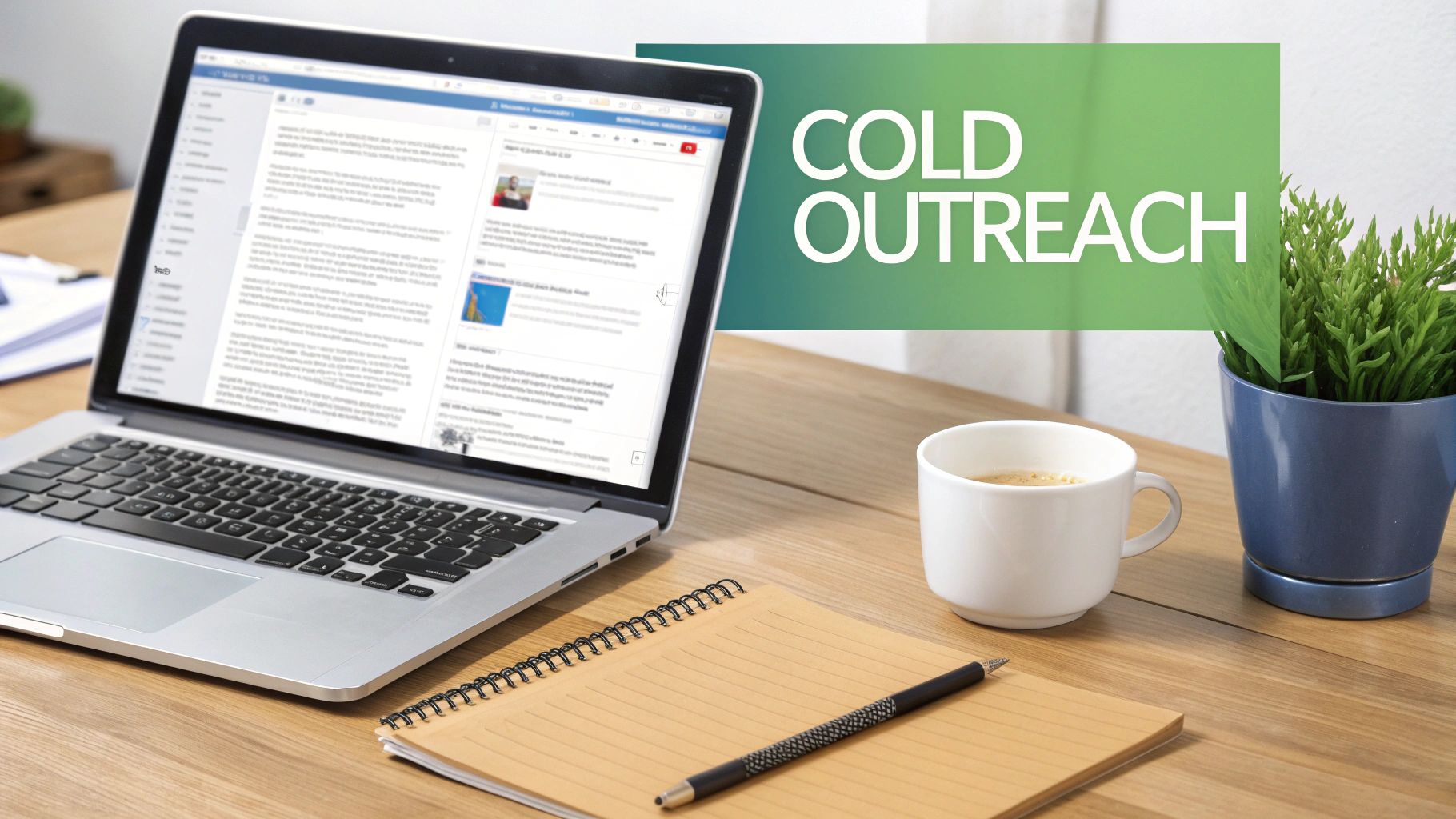
This strategy is essential for sales representatives targeting new markets, freelancers showcasing their skills, or founders seeking investment. The goal isn't to close a deal in the first email but to start a meaningful conversation.
Example: A Freelancer Pitching Services
Subject: Idea for [Recipient Company]'s blog content
Hi [Recipient Name],
I noticed your recent article on [Specific Topic] and was impressed by your insights into the B2B SaaS space. Your point about [Specific Detail] was especially sharp.
My name is [Your Name], and I specialize in writing long-form content for tech companies like [Similar Company 1] and [Similar Company 2], helping them increase organic traffic by an average of 40% in six months.
Given your focus on [Company's Goal, e.g., expanding into new markets], I believe your blog could benefit from a deep-dive article on [Relevant Topic Idea]. I have an outline prepared and would be happy to share it.
Would you be open to a brief 10-minute chat next week to discuss this?
Best,
[Your Name]
Strategic Breakdown
- Personalized Hook: The email opens by referencing a specific article, proving the sender did their research. This immediately separates it from generic spam.
- Quick Introduction & Social Proof: The sender clearly states who they are and backs it up with a quantifiable achievement ("increase organic traffic by an average of 40%") and relevant client names.
- Value Proposition: Instead of just asking for work, the sender offers a tangible, relevant idea ("a deep-dive article on [Relevant Topic Idea]") that aligns with the recipient's known goals.
- Clear, Low-Friction Call-to-Action (CTA): The request for a "brief 10-minute chat" is specific and minimizes the perceived time commitment, making it easier for the recipient to say yes.
Actionable Takeaways
- Research is Non-Negotiable: Spend at least five minutes researching your contact. Find their recent work, company news, or a LinkedIn post you can genuinely reference.
- Lead with Value, Not an Ask: Frame your email around how you can help them, not how they can help you. Offer a specific idea, an observation, or a resource. For a deeper dive into crafting compelling messages, you can explore these professional writing tips.
- Keep it Concise: Your email should be skimmable, ideally under 150 words. Use short paragraphs and get straight to the point. The recipient is busy; respect their time.
2. The Meeting Request Email
The meeting request email is a fundamental tool in professional communication, designed to efficiently schedule appointments while setting clear expectations. Far from a simple "Are you free?", this professional email example provides context, purpose, and logistical details upfront. This approach, perfected by executive assistants and project managers, minimizes back-and-forth communication and ensures all participants arrive prepared and aligned.
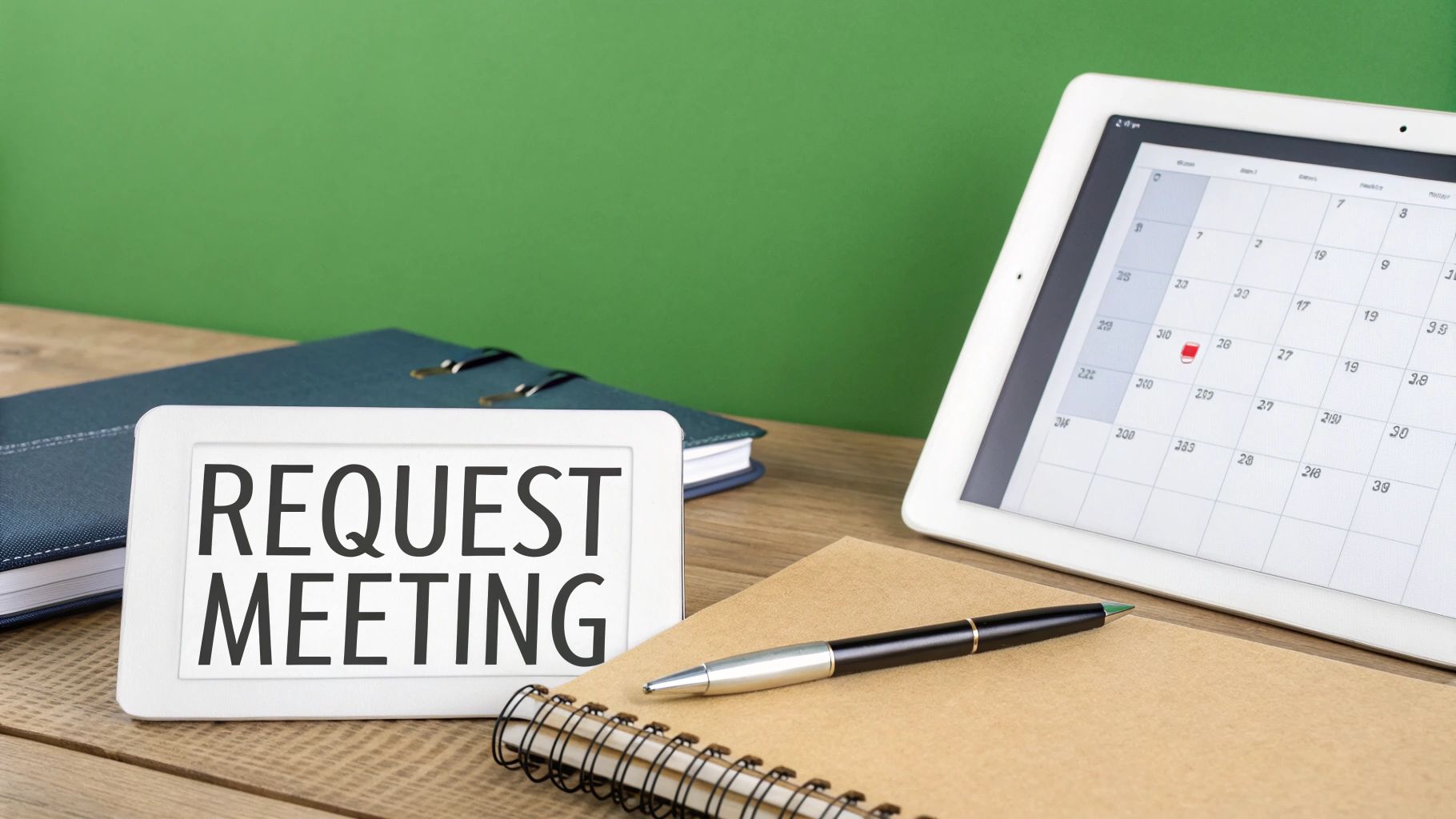
This email is crucial for anyone coordinating with others, from HR managers scheduling interviews to consultants booking client consultations. The goal is to make saying "yes" and preparing for the meeting as seamless as possible for the recipient.
Example: A Project Manager Coordinating a Team Meeting
Subject: Meeting: Q3 Project Kick-off for "Project Phoenix"
Hi Team,
To align on our goals and timeline for Project Phoenix, I'd like to schedule a 30-minute kick-off meeting next week.
The primary objective is to finalize the project scope and assign initial tasks. A brief agenda is attached for your review.
Please let me know which of the following times works best for you:
- Tuesday, Oct 26th at 10:00 AM EST
- Wednesday, Oct 27th at 2:30 PM EST
- Thursday, Oct 28th at 11:00 AM EST
If none of these times work, please suggest an alternative. Once we have a consensus, I will send a calendar invitation with the video conference link.
Thanks,
[Your Name] Project Manager
Strategic Breakdown
- Clear Subject Line: The subject explicitly states the meeting's purpose and topic ("Q3 Project Kick-off for 'Project Phoenix'"), allowing for easy searching and prioritization in a crowded inbox.
- Purpose-Driven Opening: The email immediately clarifies the "why" behind the meeting, framing it as a necessary step to "align on our goals and timeline."
- Defined Agenda & Objective: Mentioning the objective ("finalize the project scope and assign initial tasks") and an attached agenda shows respect for everyone's time and encourages preparation.
- Frictionless Scheduling: Offering specific, pre-selected time slots reduces the cognitive load on recipients. They only need to choose, not research their entire calendar. The email also provides a clear fallback option.
Actionable Takeaways
- Propose, Don't Ask Openly: Never use vague questions like "When are you free?" Always propose 2-3 specific time slots. This shifts the task from a difficult search to a simple choice.
- State the Goal and Duration: Every meeting request must include a clear objective and an estimated duration. This helps the recipient gauge the meeting's importance and fit it into their schedule. To sharpen this skill, consider exploring resources about effective business writing skills.
- Handle Logistics in Advance: Specify the meeting format (e.g., video call, in-person) and mention that a formal calendar invite with all necessary links or addresses will follow. This preempts follow-up questions.
3. The Follow-Up Email
The follow-up email is a critical professional tool for maintaining momentum after an initial interaction. Whether sent after a job interview, a sales meeting, or a networking event, its purpose is to demonstrate proactivity, reiterate value, and keep the conversation alive. This professional email example is not about pestering; it’s a strategic move to show you're engaged, organized, and serious about the potential relationship.
This strategy is essential for anyone looking to convert an initial contact into a tangible outcome. Sales teams use it to guide prospects through the funnel, job seekers use it to stay top-of-mind with hiring managers, and consultants use it to solidify client relationships by providing clear summaries and next steps. The goal is to move the relationship forward respectfully and efficiently.
Example: Post-Meeting Follow-Up
Subject: Quick recap of our chat about [Project Name/Topic]
Hi [Recipient Name],
It was great connecting with you earlier today and learning more about [Recipient Company]'s goals, especially regarding [Specific Goal Discussed, e.g., streamlining your onboarding process].
To summarize our discussion, we covered:
- The current challenge with [Specific Pain Point].
- How our [Product/Service] can address this by [Specific Benefit 1] and [Specific Benefit 2].
- The next steps, which include me sending over the detailed proposal by EOD Friday.
As promised, I've attached the case study on how we helped [Similar Company] achieve a 30% reduction in customer churn.
Let me know if you have any questions before I send the proposal over.
Best regards,
[Your Name]
Strategic Breakdown
- Timely & Contextual Subject Line: The subject line is clear, references the recent meeting, and makes it easy for the recipient to identify and prioritize.
- Recap Key Points: Using a bulleted list to summarize the discussion respects the recipient's time, reinforces the key takeaways, and confirms mutual understanding.
- Deliver on Promises: The sender immediately follows through by attaching the promised case study, building trust and demonstrating reliability.
- Reiterate Next Steps: It clearly outlines the next action item and sets a timeline ("sending over the detailed proposal by EOD Friday"), which manages expectations and maintains momentum.
Actionable Takeaways
- Act Promptly: Send your follow-up within 24 hours of the meeting or interaction. This ensures the conversation is still fresh in the recipient's mind and signals your efficiency.
- Add New Value: Each follow-up should offer something new. This could be a summary, a promised resource, an answer to a question, or a relevant article. Avoid simply asking, "Have you had a chance to look at my previous email?"
- Be Politely Persistent: Don't give up after one attempt. A well-spaced follow-up sequence shows commitment without being annoying. Plan for 3-5 follow-ups before closing the loop.
4. The Thank You Email
The thank you email is a cornerstone of professional communication, used to express gratitude and build lasting goodwill. More than just polite follow-up, this professional email example reinforces positive interactions and keeps the lines of communication open. Popularized by executive coaches and career advisors, it's a simple yet powerful gesture that demonstrates professionalism, attentiveness, and appreciation after interviews, meetings, or receiving help.
This strategy is crucial for job candidates looking to stand out, professionals nurturing their network, and business leaders fostering strong partnerships. The objective is to solidify a positive impression and strengthen the relationship by acknowledging the other person's time and effort.
Example: A Post-Interview Thank You
Subject: Thank you - Marketing Manager Interview
Hi [Interviewer Name],
Thank you again for taking the time to speak with me today about the Marketing Manager role at [Company Name]. I truly enjoyed our conversation and learning more about the team's focus on data-driven content strategies.
I was particularly interested in your plans to expand into video marketing this year. My experience growing a YouTube channel for [Previous Company] from 1k to 50k subscribers in 12 months aligns directly with that goal, and I'm confident I could help drive similar results for your team.
My enthusiasm for this opportunity and for [Company Name] has only increased after our discussion. I look forward to hearing about the next steps and am happy to provide any additional information you might need.
Best regards,
[Your Name]
Strategic Breakdown
- Prompt and Specific Subject Line: The subject is clear and includes the job title, making it easy for the busy hiring manager to identify and categorize.
- Genuine Appreciation: The opening is direct and expresses sincere thanks, referencing the specific role and company to show it's not a generic template.
- Reiterate Value and Connection: The email strategically connects a specific point from the conversation (video marketing) to the candidate's relevant experience and quantifiable success ("from 1k to 50k subscribers"). This reinforces their qualifications.
- Professional Closing: The closing expresses continued interest without being pushy and offers further assistance, showing a proactive and cooperative attitude.
Actionable Takeaways
- Act Within 24 Hours: Send your thank you email within a day of the interaction. This timing shows you are prompt, organized, and genuinely interested.
- Be Specific, Not Generic: Reference a specific topic you discussed. This proves you were actively listening and helps the recipient recall the conversation, making you more memorable. For more on this, you can learn how to write compelling content that resonates.
- Keep it Concise and Sincere: A thank you email should be heartfelt but brief, typically under 150 words. Focus on expressing gratitude and subtly reinforcing your value proposition.
5. The Apology and Resolution Email
Mistakes are inevitable in any business, but how you handle them defines your professionalism and integrity. The apology and resolution email is a critical tool for addressing errors, service failures, or misunderstandings directly and effectively. This professional email example is not about making excuses; it's about taking ownership, outlining a clear solution, and rebuilding trust with the affected party.
This strategy is vital for customer service teams handling service failures, project managers communicating delays, or any professional who needs to correct a mistake. The goal is to acknowledge the issue swiftly, demonstrate accountability, and provide a concrete path forward, turning a negative experience into an opportunity to reinforce the relationship.
Example: A Project Manager Notifying a Client of a Delay
Subject: Update and Action Plan for Project [Project Name]
Hi [Client Name],
I am writing to inform you about an unexpected delay in the delivery of the [Specific Project Milestone]. The new projected completion date is now [New Date].
This delay was caused by [Brief, transparent reason, e.g., an unforeseen technical issue with our third-party API integration], and I take full responsibility for this oversight and its impact on our timeline.
To get us back on track, we have already [Specific Action 1, e.g., assigned a senior developer to resolve the integration issue] and are [Specific Action 2, e.g., reallocating resources to expedite the subsequent phases]. I will provide you with a daily progress report until this is fully resolved.
I sincerely apologize for the inconvenience this has caused. I am available to discuss this further at your convenience.
Best regards,
[Your Name] Project Manager
Strategic Breakdown
- Direct and Transparent Opening: The email immediately states the problem and the new timeline. There is no attempt to soften the bad news or bury it in pleasantries.
- Clear Accountability: The sender uses "I take full responsibility," which is crucial for de-escalating frustration. It avoids blame-shifting and shows leadership.
- Action-Oriented Solution: It doesn't just state the problem; it presents a clear, two-part action plan already in motion. This demonstrates proactivity and a commitment to resolution.
- Sincere Apology and Open Channel: The apology is straightforward, and the offer to discuss further gives the client control and shows respect for their concerns.
Actionable Takeaways
- Act with Urgency: When a mistake occurs, your response time is critical. A prompt apology shows you are taking the issue seriously and value the relationship.
- Own the Mistake Completely: Avoid using conditional language or blaming external factors. A simple, "We made an error, and I am responsible" is far more powerful than a list of excuses.
- Focus on the Solution, Not Just the Problem: While acknowledging the issue is important, the bulk of your email should detail the concrete steps you are taking to fix it and prevent it from happening again. This shifts the focus from failure to recovery.
6. The Networking and Introduction Email
The networking and introduction email is a fundamental tool for career growth, designed to build new professional relationships or strengthen existing ones. It operates on the principle of mutual value, leveraging shared connections, interests, or experiences to create a warm opening. This professional email example is crucial for anyone looking to expand their professional circle, from recent graduates reaching out to alumni to seasoned professionals following up after an industry event.

Unlike a cold outreach, this email typically has a "warm" element, a common ground that bridges the gap between strangers. The goal is not to make a hard sell but to initiate a genuine connection that could lead to mentorship, collaboration, or future opportunities. It’s the digital equivalent of a firm handshake and a meaningful conversation at a conference.
Example: Following Up After an Industry Event
Subject: Great connecting at [Event Name]!
Hi [Recipient Name],
It was a pleasure meeting you yesterday at the [Event Name] conference. I really enjoyed our conversation at the networking lunch about the future of AI in project management.
Your insights on [Specific Topic Discussed, e.g., predictive analytics for resource allocation] were particularly fascinating, and it got me thinking. I remembered an article I read recently on that exact subject that you might find interesting: [Link to a Relevant Article].
I'd love to continue our conversation sometime. Would you be open to a quick coffee or a 15-minute virtual call in the coming weeks?
Best regards,
[Your Name]
Strategic Breakdown
- Contextual Reminder: The subject line and opening sentence immediately remind the recipient where and when they met, jogging their memory and establishing relevance.
- Reference a Specific Conversation: Mentioning a specific detail from the conversation ("AI in project management") proves the interaction was memorable and your interest is genuine. This personalization is key.
- Provide Immediate Value: Instead of asking for something, the sender offers a helpful resource (a relevant article). This selfless gesture reinforces a positive impression and frames the relationship as mutually beneficial.
- Low-Commitment CTA: The call-to-action is flexible and low-pressure, offering options ("quick coffee or a 15-minute virtual call") that respect the recipient's busy schedule and preferences, increasing the likelihood of a "yes."
Actionable Takeaways
- Act Quickly: Send your follow-up email within 24-48 hours of meeting someone. The conversation will still be fresh in both of your minds, making your message more impactful.
- Find Your Common Ground: Always anchor your email in a shared context, whether it's a mutual connection, a shared alma mater, or a recent event. This is the foundation of a warm introduction.
- Focus on Relationship-Building: The primary goal is to build rapport, not to extract value. Frame your outreach around genuine interest and a desire to connect. The opportunities will follow naturally from a strong professional relationship.
Professional Email Types Comparison
| Email Type | ⭐ Expected Outcomes | 🔄 Implementation Complexity | ⚡ Resource Requirements | 💡 Ideal Use Cases | 📊 Key Advantages |
|---|---|---|---|---|---|
| The Cold Outreach Email | Moderate lead generation; low response rate | High (requires research + personalization) | Moderate (time for research and crafting) | Business development, freelancers, startup funding | Scalable; cost-effective; builds new networks |
| The Meeting Request Email | High meeting scheduling success; reduces back-and-forth | Medium (requires clear agenda + logistics) | Low to moderate (calendar tools, info prep) | Scheduling client meetings, interviews, presentations | Efficient scheduling; professional impression |
| The Follow-Up Email | Increased conversion rates; maintains momentum | Medium (timing and personalization critical) | Moderate (time for personalization) | Post-meeting, post-interview, proposal follow-ups | Strengthens relationships; demonstrates reliability |
| The Thank You Email | Positive lasting impression; goodwill building | Low (brief and focused message) | Low (minimal time investment) | Post-interview, referrals, events, partnerships | Builds trust; encourages future opportunities |
| The Apology and Resolution Email | Restores trust; prevents issue escalation | Medium to high (requires careful wording) | Moderate (legal and strategic input may needed) | Customer service, project delays, billing corrections | Demonstrates accountability; strengthens relationships |
| The Networking and Introduction Email | Expands network; creates collaboration chances | High (needs genuine personalization) | Moderate (time for research and follow-up) | LinkedIn outreach, alumni reconnects, industry introductions | Builds social capital; leads to referrals and partnerships |
From Templates to Triumphs: Making These Emails Your Own
Throughout this guide, we have explored a diverse collection of professional email examples, moving far beyond simple copy-and-paste solutions. From initiating cold outreach to navigating delicate apologies, we have dissected the anatomy of effective communication. Each template, whether for a follow-up, a meeting request, or a critical networking introduction, serves as a strategic blueprint.
The core lesson is that a powerful email is never just about the words you choose; it is about the strategy behind them. The most successful professionals understand that an email is a tool for building relationships, driving action, and achieving specific outcomes.
Recapping the Core Strategies
As you move forward, keep these foundational principles at the forefront of your email writing process:
- Clarity Above All: Every email must have a singular, clear purpose. Your recipient should immediately understand why you are writing and what you need from them. This was the central theme in our meeting request and follow-up examples.
- Empathy is Your Superpower: Put yourself in your recipient's shoes. Acknowledge their perspective, respect their time, and tailor your message to their needs. This approach is non-negotiable for apology emails and crucial for effective cold outreach.
- Structure Creates Success: A predictable, scannable format is key. The combination of a strong subject line, a concise opening, a well-organized body, and a clear call to action creates a user-friendly experience that dramatically increases your chances of getting a response.
Turning Blueprints into Masterpieces
The true power of any professional email example lies not in its verbatim use, but in its adaptability. Think of the templates we have provided as a starting point or a foundational structure. Your next step is to infuse them with your unique voice, industry-specific context, and genuine personality.
Consider these actionable steps to make these templates your own:
- Identify the Core Framework: For any new email you need to write, first match its purpose to one of the examples provided (e.g., "This is a follow-up, so I'll use that structure").
- Personalize the Key Touchpoints: Swap out generic placeholders with specific details. Mention a recent accomplishment of their company, a shared connection, or a specific point from a previous conversation.
- Adjust the Tone: Calibrate your language to match your relationship with the recipient and your industry's norms. An email to a long-term colleague will sound different from a formal networking request.
- Refine Your Call to Action (CTA): Ensure your CTA is direct, simple, and provides a clear next step. Avoid ambiguity at all costs.
Mastering email communication is a journey of continuous refinement. By combining these proven strategies with authentic personalization, you elevate your emails from mere messages into powerful instruments for career growth, relationship building, and professional success.
Have you ever drafted the perfect email, only for it to feel stiff or robotic? Natural Write helps you humanize your text, refining your tone and clarity to ensure your message connects authentically. Turn your effective drafts into exceptional communications by visiting Natural Write to see how it transforms your writing.
